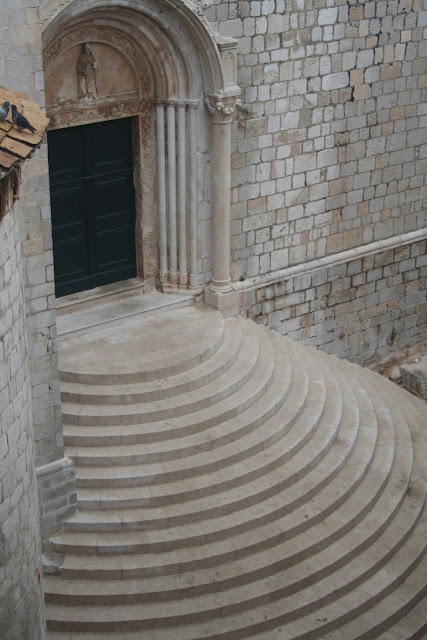For centuries Dubrovnik was the biggest rival of Venetian republic in the Adriatic coast. Dubrovnik has always been big in trade due to its location near the sea, which contributed to most of its wealth. During the middle ages, the city of Dubrovnik became a competitor and a rival for Venice. The city had good numbers of skilled labor and money and as a result of which, saw enormous growth during the 15th and the 16th century. The city was also a home for notable poets, painters, politicians, play writers and scholars. In the late 18th century both Dubrovnik and Venice were met with the same ending – Napoleon.
Dubrovnik attracts thousands of tourists every day but fortunately it managed to keep its unique atmosphere and its local life.
 |
| Patrick on the Stradun nearS t Blaise |
My adventure into Dubrovnik was with my son, Patrick. We were there on a Mediterranean cruise. We enjoyed our stop to simply explore the city. The beauty is just extraordinary and only enhanced by the uniqueness of it all. Dubrovnik is unlike any other city in Europe. Reflecting back on it now the one element that comes to mind when I think if Dubrovnik is the cleanliness of the city.
Dubrovnik is famous for roaming destinations like Roland’s Column, the Bell Tower, the Sponza Place, War Photo Limited, Pile Gate, and some famous churches and museums.

Right in front of the Pile Gate entrance is the circular Onofrio Fountain built in the 15th century and sporting 16 carved masks. Unlike the rest of Dalmatia, Dubrovnik citizens were not relegated to capturing rainwater; the fountain was connected by aqueduct with a spring near the town.
 |
| Patrick at Onofrio Fountain |
The Church of St Blaise (Crkva Sv Vlaho) is Dubrovnik's most beloved church, partly because St Blaise is the patron saint of Dubrovnik. Most festivals in Dubrovnik begin or end or have something to do with this church, conveniently located at the eastern end of Stradun. A recent restoration left the facade gleaming and the stairs are a perfect resting place for bedraggled tourists.

Stylistically, the church is stately but with welcoming ornamentation that pleases the eye without overwhelming the surroundings. The Venetian architect Marino Gropelli oversaw the church's construction which was finished in 1715. It was built on the site of an earlier church that was destroyed in a fire several years earlier. The only surviving remnant of that church was a 15th-century statue of St Blaise who holds a model of medieval Dubrovnik in his hand.The statue is now incorporated into the main altar. Also saved were two stone figures of saints made by Nikola Lazanic from Brac at the end of the 16th century.
 |
| Watercolor of St. Blaise purchased in Dubrovnik |

The Stradun is the main street of Old Town. It runs from the Pile Gate on the west to Ploce Gate on the east. The paving stones were laid in 1468.

Dubrovnik's old city walls run over a mile around the city. Walking on the city walls is a popular tourist activity.

The city walls complete with turrets, towers and staircases were constructed in the 10th century and fortified in 1453. The walls are 4 to 6 meters thick (13 to 20 ft) on the landward side but are much thinner on the seaward side.

Old Town Dubrovnik is entirely pedestrian so walking is the only way to get around.

Many of the little streets north of the Stradun rise up in seemingly endless stairs.

Dubrovnik was heavily bombed during the Croatian War of Independence from 1991 to 1995. Almost all of the damage has been repaired; however, if you look closely around the old town, mortar damage in the cobblestone streets and bullet marks in the stone houses are visible.
 |
- Posted using BlogPress from my iPad








Hi Kim,
ReplyDeleteI must correct you, on the last picture it is not bomb damage, those are old ruins in "Karmen", excavated where previously basketball court was